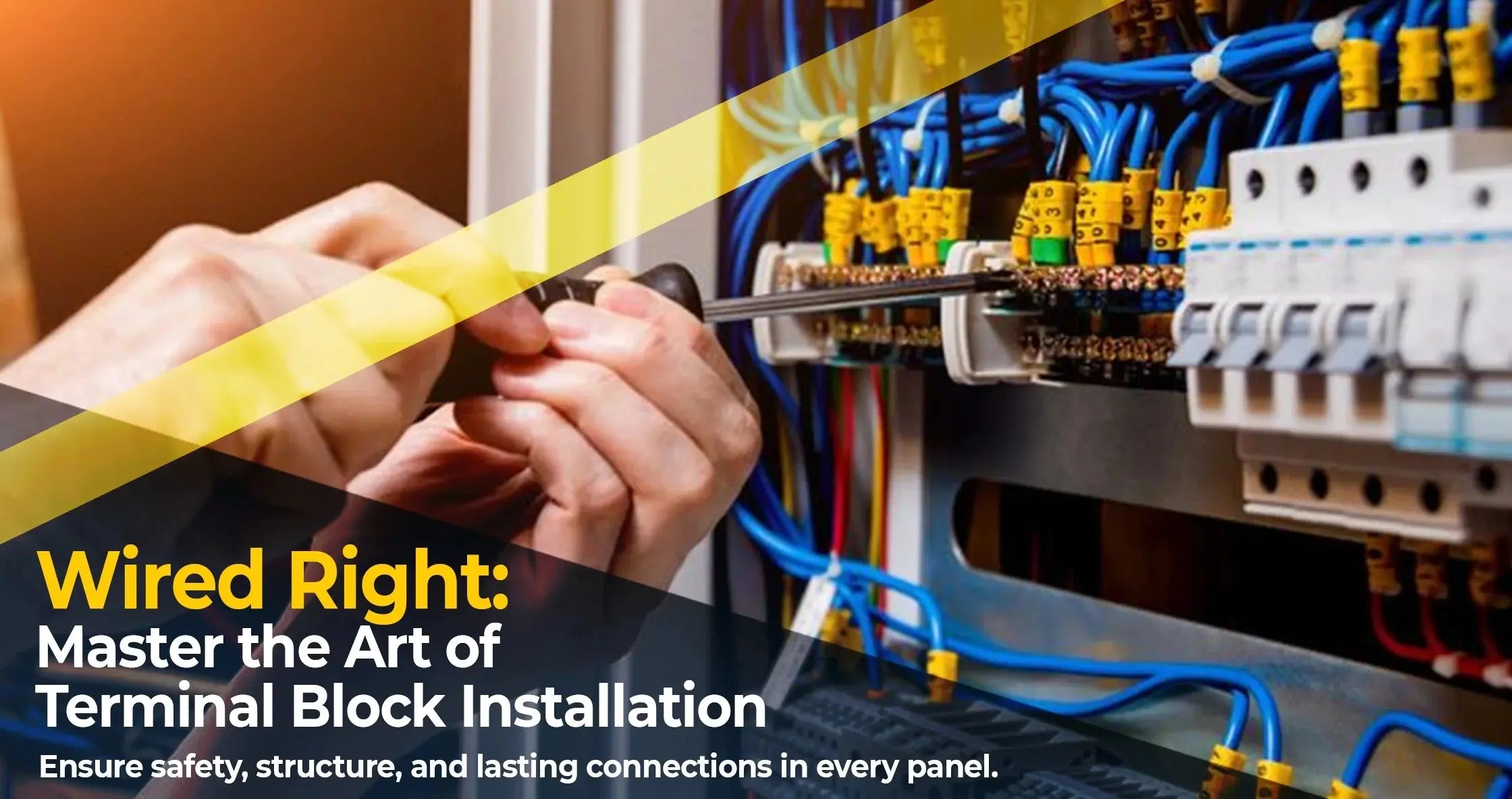Los bloques de terminales desempeñan un papel crucial en los paneles eléctricos, ya que sirven como punto seguro y organizado para las conexiones de cables. Su correcta instalación garantiza el funcionamiento de los sistemas eléctricos y la seguridad de los usuarios. En este artículo, exploraremos consejos esenciales de instalación para bloques de terminales, ayudándole a comprender las complejidades de este componente crítico.
Comprensión de los bloques de terminales
Los bloques de terminales son componentes estructurales que fijan los cables para mantener conexiones eléctricas seguras y fiables. Están disponibles en varios modelos, incluyendo bloques de terminales de tornillo, de inserción a presión y de resorte. Cada tipo tiene sus propias ventajas, lo que los hace adecuados para diferentes aplicaciones, como la electrónica industrial y de consumo.
Tipos de bloques de terminales
Existen varios tipos de bloques de terminales, diseñados para funciones específicas. Entre ellos se incluyen los bloques de terminales de tornillo, que se fijan con tornillos, y los bloques de terminales a presión, donde los cables se insertan simplemente a presión. Cada tipo presenta características únicas que los hacen adecuados para aplicaciones específicas. Por ejemplo, un bloque de terminales Sprecher + Schuh ofrece fiabilidad y durabilidad en diversos entornos.

Aplicaciones
Los bloques de terminales tienen numerosas aplicaciones, como paneles de control, maquinaria y sistemas de automatización. Su versatilidad les permite gestionar eficazmente tensiones y corrientes, lo que los hace indispensables en diversas industrias, como la manufactura y la construcción. Una instalación correcta puede mejorar significativamente la funcionalidad de los sistemas eléctricos.
Preparación antes de la instalación
Antes de instalar los bloques de terminales, es fundamental realizar preparativos exhaustivos. Primero, reúna las herramientas necesarias, como destornilladores, alicates y pelacables. Revise el manual de instalación y familiarícese con las especificaciones del bloque de terminales para garantizar su compatibilidad con el sistema.
Planificar el diseño
Antes de la instalación, conviene planificar la disposición de los bloques de terminales. Una disposición clara minimiza la confusión durante el proceso de instalación. Evalúe el espacio disponible en el panel eléctrico y asegúrese de que haya suficiente espacio para montar los bloques de terminales, cumpliendo con la normativa local.
Cumplimiento de las normas
Antes de proceder con la instalación, asegúrese de que los bloques de terminales seleccionados cumplan con las normas eléctricas y de seguridad locales. Este cumplimiento evitará riesgos como cortocircuitos o sobrecargas que podrían provocar fallos en el sistema.
Proceso de instalación
Ahora que ha preparado sus herramientas y el diseño, es hora de centrarse en el proceso de instalación. Siga los pasos sistemáticos para garantizar una instalación segura y eficiente.
Montaje del bloque de terminales
Comience fijando firmemente el bloque de terminales al riel DIN o al panel con los tornillos adecuados. Asegúrese de que esté nivelado y no se tambalee, ya que un soporte sólido garantiza mejores conexiones y reduce el desgaste con el tiempo. Cada bloque debe estar correctamente orientado para una accesibilidad y disposición óptimas.
Realizar conexiones de cables
Pele los cables para exponer los conductores desnudos. Insértelos con cuidado en los terminales correctos de los bloques de terminales, asegurándose de que estén bien fijados. En los bloques de terminales de tornillo, apriete los tornillos hasta que queden bien ajustados; evite apretarlos demasiado, ya que podría dañar el cable o el bloque.
- Asegúrese de que los tamaños de los cables coincidan con las especificaciones del bloque de terminales.
- Confirme la polaridad antes de asegurar los cables para evitar cortocircuitos.
- Segmente diferentes circuitos lógicamente para simplificar la resolución de problemas.
Pruebas y resolución de problemas
Al finalizar la instalación, es fundamental realizar pruebas para garantizar que todo funcione correctamente. Conecte el sistema eléctrico y verifique si hay alguna señal de mal funcionamiento.
Realización de pruebas
Use un multímetro para verificar que el voltaje en las conexiones sea el esperado. Si hay discrepancias, revise si hay conexiones sueltas o desalineadas. Resuelva cualquier problema de forma proactiva para garantizar la seguridad y el funcionamiento.
Solución de problemas comunes
Algunos problemas comunes a los que debe prestar atención incluyen conexiones sueltas o señales de sobrecalentamiento. Si experimenta cortes de electricidad frecuentes, inspeccione los bloques de terminales y el cableado para asegurarse de que estén seguros y sin daños. Repare de inmediato la corrosión o la decoloración de los bloques de terminales, ya que pueden indicar desgaste y comprometer la integridad eléctrica.
Conclusión
En conclusión, comprender la correcta instalación de los bloques de terminales es esencial para garantizar una conexión eléctrica eficiente y segura. Siguiendo estos consejos esenciales de instalación, que incluyen una preparación exhaustiva, el cumplimiento de las normas de seguridad y procesos sistemáticos de cableado y pruebas, podrá mejorar la fiabilidad y el rendimiento de sus sistemas eléctricos. Recuerde elegir bloques de terminales de calidad, como el bloque de terminales Klippon, para garantizar aplicaciones seguras y duraderas. Las técnicas de instalación correctas se traducirán en un entorno eléctrico más eficiente y seguro.

Conclusión clave
Dominar la instalación de bloques de terminales implica comprender sus funciones, preparar el espacio de trabajo, cumplir con las normas de seguridad y garantizar conexiones seguras. Las pruebas y el mantenimiento periódicos ayudarán a mitigar posibles problemas y a prolongar la vida útil de sus sistemas eléctricos.
Preguntas frecuentes (FAQ)
A continuación se presentan algunas preguntas comunes sobre las instalaciones de bloques de terminales.
-
¿Qué herramientas necesito para la instalación del bloque de terminales?
Normalmente necesitará un destornillador, una crimpadora y un pelacables. Tener las herramientas adecuadas a mano facilitará la instalación.
-
¿Cómo puedo asegurarme de tener buenas conexiones?
Asegúrese de que el cable esté bien pelado y encaje firmemente en el bloque de terminales. En los bloques de terminales de tornillo, apriete los tornillos para sujetar el cable firmemente en su lugar, pero evite apretarlos demasiado.
-
¿Cuáles son las precauciones de seguridad a tener en cuenta?
Desconecte siempre la alimentación eléctrica antes de trabajar en paneles eléctricos. Siga las instrucciones de instalación del fabricante e inspeccione periódicamente las conexiones para detectar desgaste o daños.

